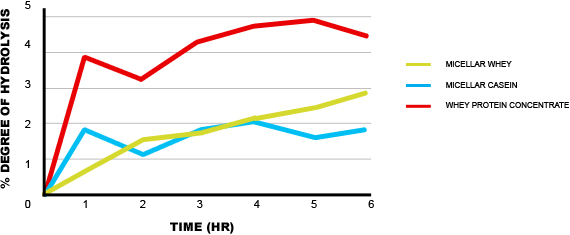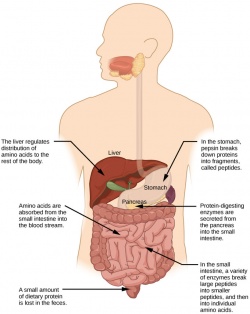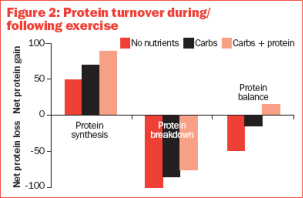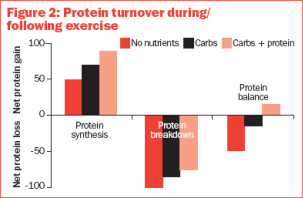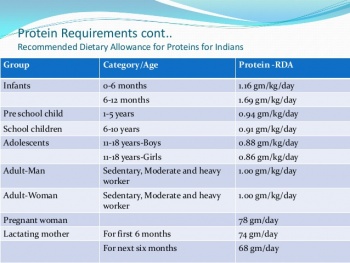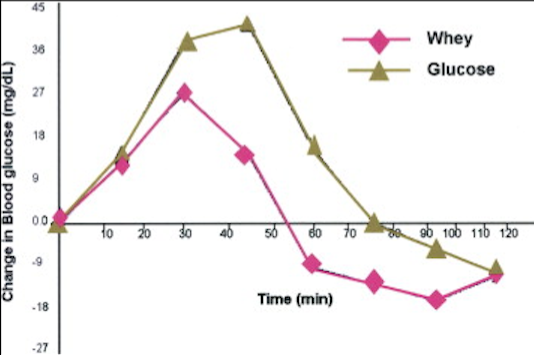Exercise and Protein Supplements
Introduction[edit | edit source]
Containers of protein powders line the shelves of many supplement stores and are typically a highly purchased product. Protein supplements can be used for a variety of reasons such to help build muscle mass, help with exercise recovery, and can even be used as a meal replacement. Due to the wide variety of usages, this supplement will be used by many types of people and found commonly in a physical therapy clinic. As a physical therapist it is crucial to know how protein metabolizes, the different types of protein supplements that are commonly sold, the effects on timing of ingestion of protein supplements, how protein effects different types of exercise, how age and gender influence protein supplementation, and any additional side effects protein supplements may have.
Types of Protein Supplements
[edit | edit source]
There is a wide variety of Protein supplementation options. The most common types of supplementation include: Whey, Casein, and Soy.
Whey[edit | edit source]
The leucine, isoleucine, and valine content in whey and its ease of digestibility make it one of the highest-quality proteins [1]. Whey is a protein that is a by-product in cheese production. Whey accounts for 20% of the protein found in milk. This protein metabolizes fast and is the most popular type of the three. Whey is also high in muscle-building amino acids like leucine, isoleucine, and valine. There are two main types of whey protein sold as well as a blend of the two together. These variations are Whey Isolate and Whey Concentrate. Isolate tends to be higher quality and contains between 90 and 98% protein. Concentrate contains between 70 and 85% protein [2]. Muscle hypertrophy occurs at a greater rate with the consumption of whey protein over soy or casein[1].
Casein[edit | edit source]
Casein is a protein that makes up the remaining 80% of the protein in milk. Casein digests slowly and is a popular choice as a weight gainer. It contains a little more than 90% protein in general and encourages the body to metabolize carbs and fats first. Casein is also a popular choice for muscle building.
Soy[edit | edit source]
Soy protein is a fast digesting protein that is of high quality. It is not as efficient as the milk proteins; therefore, it is not as desirable for those looking to build muscle.
Soy protein supplementation has had a lot of controversy over its effect on muscle through use with resistance training, but also the positives and negatives of some of its potential side effects. The main content of soy protein supplements is the soy bean. In a 2006 study, the effects of whey and soy protein with resistance training young men and women in comparison to a blinded control group. The results showed that soy protein in combination with resistance training produces the same effects as whey protein supplementation. [3]
How Protein Metabolizes and Protein's Effects on the Body[edit | edit source]
Protein metabolism in the body occurs differently from the other macronutrients, as there is no type of storage for proteins. Proteins are composed of Carbon, Hydrogen, and Oxygen, and Nitrogen. Amino acids are the building blocks of proteins, and are connected by peptide bonds [5]. Amino acids are the usable form that is necessary for digestion to occur. There are 9 essential amino acids that must be consumed, and 11 non-essential amino acids that can be synthesized in the body. A complete protein contains all 9 essential amino acids, while an incomplete protein lacks one or more essential amino acids. Complete proteins are typically seen in animal products, while incomplete proteins are commonly seen in plant sources.
Protein metabolism begins in the stomach. The enzyme pepsinogen is converted to the active pepsin form when in the presence of the highly acidic hydrochloric acid (HCl). Pepsin begins to break down the peptide bonds to form dipeptides and amino acids necessary for digestion. Enzymes, including Trypsin, Chymotrypsin, and Carboxypeptidase, from the pancreas and small intestine are also secreted when needed to break any remaining peptide bonds that escaped the stomach. The amino acids are then absorbed in the small intestine and released in the blood stream [6].
Proteins are responsible for a number of roles in the body. However, while carbohydrate and fats can be used for energy, proteins do not supply energy directly to the body. Instead proteins are utilized to form blood transporters, enzymes, participate in hormonal regulation, fluid balance, and acid-base balance, and act as a structural component in connective tissue and muscle [5].
Timing of Protein Supplementation[edit | edit source]
Before and/or During Exercise:[edit | edit source]
Minimal research exists supporting the positive impact of protein supplementation before or during exercise. The majority of studies completed have been inconclusive; however, one study showed that the ingestion of protein before and/or during exercise "stimulates muscle protein synthesis during exercise. Therefore, protein ingestion before and/or during prolonged exercise training may inhibit muscle protein breakdown, stimulate muscle protein synthesis, and further augment the skeletal muscle adaptive response to exercise training."[7] The same study stated that, "Dietary protein ingestion before and/or during exercise may provide more effective feeding strategy to improve amino acid availability during early post-exercise recovery."[7]
After Exercise:[edit | edit source]
Protein plays a very important role in the recovery process following exercise. Whether ingested in in the form a powder supplement listed above or a high quality, whole foods meal, protein acts as a catalyst to jumpstart and improve muscular adaptations. One study showed that, "A post-exercise protein meal accelerates recovery of static force and dynamic power production during the delayed onset muscle soreness (DOMS) period"[8]. A recent systematic review showed that the intake of protein after exercise has "beneficial effects such as reduced muscle soreness and markers of muscle damage"[9].
Besides exercise recovery, research shows post-exercise consumption of protein supplements can also result in improved muscular adaptations. "The intake of protein after resistance training increases plasma amino acids, which results in the activation of signaling molecules leading to increased muscle protein synthesis and muscle hypertrophy"[10]. "Dietary protein ingestion after exercise increases post-exercise muscle protein synthesis rates, stimulates net muscle protein accretion, and facilitates the skeletal muscle adaptive response to prolonged exercise training"[7].
Researchers have investigated the impact of amino acid (lysine, proline, alanine, and arginine) and/or conjugated linoleic acid (CLA) supplements administered before and after aerobic exercise on body weight, percentage body fat, waist-hip circumference, triglycerides and LDL-cholesterol levels [11]. When compared to the placebo group, results showed that waist-hip circumferences and BMI improvements of the experimental group after aerobic exercise were clinically significant.
Types of Exercise and Protein Supplementation[edit | edit source]
Aerobic Exercise [edit | edit source]
Energy and macronutrient needs, especially carbohydrate (CHO) and protein (Pro), must be met during times of high physical activity to maintain body weight, replenish glycogen stores, and provide adequate protein to build and repair tissue.The American Dietetic Association takes the stand that during extreme bouts of exercise, replenishment of CHO and Pro stores are necessary to rebuild tissues in response to the extra protein while extra CHO will restore the glycogen reserve, and both macronutrients will maintain body weight.[12] Endurance athletes usually take CHO supplements during long bouts of exercise to replenish their glycogen stores in order to continue their workout. Studies have been done to prove that carbohydrate-protein (CHO-Pro) supplementation taken after a bout of exercise improves the performance of an endurance athlete and if ingested during a bout of exercise protein oxidation is increased.[13] Even though further research is needed, it is hypothesized that protein use as an energy source is increased during a glycogen-depleted state. Improved recovery and less muscle damage have been associated with CHO-Pro drinks post--exercise. More research is needed to understand the effects of CHO-Pro post-exercise but some studies have revealed improvements in “glycogen repletion, protein balance, muscle-damage, and subsequent performance”(Saunders). [13] No matter the controversy, CHO-Pro drinks have a lot of potential for endurance athletes during and post-exercise. The balance of protein could be improved, muscle damage could decrease and a positive effect on future performance could occur due to the increase of protein intake in aerobic athletes.
www.pponline.co.uk/encyc/strength-training-for-endurance-athletes-39414#
Anaerobic Exercise[edit | edit source]
There has been limited research to show how protein supplementation effects anaerobic exercise.[14] But, increases in lean body mass correlates to resistance training and consumption of protein.Some research has shown that "protein supplements following daily training for several weeks will enhance gain in VO2max in previously untrained individuals or athletes at the beginning of their seasonal training programs or result in improvements in tests of aerobic and anaerobic power for athletes during their normal trianing programs"(Pasiakos). For some resistance trained individuals, strength is their goal for training. Muscles with a greater cross sectional area are able to produce more force. Increasing the total amount of protein consumed in a day is the greatest predictor of muscle hypertrophy and can increase a muscles mass and the amount of force it is able to produce. Also protein supplementation has been proven to decrease the amount of muscle degeneration after a bout of exercise[1]. However, further reasearch is needed to determine how protein supplementation can effect gains in anaerobic power.
www.pponline.co.uk/encyc/strength-training-for-endurance-athletes-39414#
Protein Supplementation in Trained vs Untrained Athletes[edit | edit source]
Protein supplementation's ability to increase hypertrophy and decrease muscle soreness following resistance training makes it a popular choice among every level of athlete.[10][7] From professional athletes to those starting a training regimen for the first time, people are taking protein supplements to take advantage of the benefits it can have on muscular adaptations. However, recent research suggests that during the first few weeks of exercise, it is unlikely for protein supplements to show any impact on lean mass and muscle development in untrained individuals.[14] As intensity, frequency, and duration begin to increase and grow, protein supplements will then become advantageous.[14]
Implications for Physical Therapy[edit | edit source]
It is important for a physical therapist to know if their patient is taking protein supplementation in order to help educate them about their protein intake routine and to inform them of potential side effects. Physical therapists can also use their platform to inform their patients about the benefits of protein. Research suggests protein can positively affect those with chronic obstructive pulmonary disease (COPD), heart failure, and chronic kidney disease (CKD) but research needs to be furthered to fully support these claims. These are only some examples of how protein intake can affect patients in the clinic. This section will further discuss some of the ways an increased protein intake can improve a patient’s functional abilities.
Cerebrovascular Accidents (CVA)
[edit | edit source]
According to a study in 2014, strokes are the world's leading cause of disibility[15]. The American Heart Association found that 16% of patients with strokes admitted to the hospital are malnourished. After just one week in the hospital, 24% of patients with CVAs are considered malnourished. Patients who have experienced a stroke have lowered levels of protein synthesis when compared to a those who have not. Therefore, patients that experienced a CVA tend to have lower muscle mass and strength. If a patient is not synthesizing proteins correctly, there is a positive correlation with a poor outcome in rehabilitation[16].
Those who have suffered a stroke have difficulties with their non-paralyzed side of the body due to a “muscle fiber shift, an increase in intrasmuscular fat, spasticity, disuse, malnutrition, and muscle unloading[15]”. It was discovered that the unaffected side of the body becomes hypercatabolic due to excess of protein breakdown. Protein synthesis (anabolic activity) is lower in the unaffected side as compared to healthy individuals. In this double-blind randomized control trial, subjects were separated into two groups: a group to received essential amino acid supplements (2.5 g of leucine) and a control group and received a placebo. This study suggests amino acid infusion can increase the protein synthesis of myofibrillar, sarcoplasmic, and mitochondrial proteins by 30%[17]. Ultimately, protein ingestion can help decrease the natural degradation rate of muscle proteins in patients who have recently had a stoke.
Obesity[edit | edit source]
Obese patients often have a reduced ability to move through full range of motion due to excess soft tissue. There have been multiple studies that suggest an increase in protein can help obese patients lose body fat and gain lean muscle, which in turn increases their range of motion (ROM).
According to a randomized control trial there is evidence showing consumption of whey-protein can decrease body fat while preserving lean muscle mass amongst those who are classified as obese. In this specific study, the patients who drank two protein shakes per day saw a decrease of 6.1% in their body weight. This amount decrease is statistically significant to support a lower risk for obesity related diseases. [18]
Another study focused on aging obese patients with a focus on increased protein levels naturally- not through supplementation. This study suggests protein intake is important because those who are obese often cannot “achieve a level of physical training sufficient to induce a negative energy balance”.[19] Patients who are looking to lose weight but cannot function enough to complete physical activity at the appropriate level can benefit from increasing their protein intake- either through supplementation or through a change of eating habits. A greater outcome in rehabilitation is expected if a patient can have a higher ROM. Protein intake can increase an obese patient’s functional performance.
Sarcopenia[edit | edit source]
Sarcopenia is the gradual and progressive process of muscle mass loss and strength that is associated with aging. Participating in aerobic and resistance exercise programs has shown to lessen many aspects of sarcopenia. Along with regular exercise, proper nutrition- especially protein, is essential and can help reduce and treat declines in muscle mass. While sarcopenia is thought to be a natural part of the aging process, other factors should be considered. For instance, older adults tend to intake fewer calories, including less protein. Older adults are failing to meet their protein needs, which ultimately results in sarcopenia.[20] Patients suffering from sarcopenia can be a concern for health providers because it leads to fraility, which raises the concern for falls and fractures.
Gender and the Effects of Protein Supplementation[edit | edit source]
As of now, there is a lack of research on this topic. While there is evidence-based information on the differences between genders regarding the metabolization of protein, there is no research available claiming a difference between genders and the effects of protein supplemenation.
Age Effects and Recommendations of Protein [edit | edit source]
The recommendations for protein intake vary during different stages of life, gender, and activity level. The Estimated Average Requirements (EAR) for protein ranges from anywhere from 0.66 to about 1 gram of protein per kilogram of body weight. The Recommended Dietary Allowance (RDA) is similar to the EAR and suggests the daily requirement for adult men and women ranges from 46 to 56 grams each day[6]. Different ages and stages of life are also important to consider when recommending protein intake, due to varying requirements.
Protein requirements are increased at times of growth and development. Therefore, more protein is needed during the first year of life and during pregnancy and lactation. Protein requirements are also increased as men and women age, due to the decrease in efficiency of absorption and digestion, as well as the increase in excretion of protein in the urine.
As people get older, their bones grow weaker, and protein is an important component in bone structure that can often be overlooked in an every day diet. One study discussed protein supplements and their role in preventing hip fractures in patients, particularly post-menopausal women. The authors of the study distributed questionnaires to patients about their nutrient intake, and then followed up with them years later to determine how protein intake affected the incidence of hip fractures. They found that the incidence of hip fractures was negatively related to protein intake.[21] By encouraging and educating older patients to consume adequate amounts of protein in their daily diet, therapists can help them stay healthy and physically fit for as long as possible.
Men and women over the age of 70 should attempt to consume 57-81 grams of protein each day [6]. During the first year of life, infants grow at an exponentially faster rate than at any other time in their life. Therefore, there is an increased need for protein. Infant’s nutrition comes from the mother’s milk, which is extremely rich in protein. During pregnancy and lactation, it is suggested that women increase protein intake to about 71 grams per day, to support their child’s growth [6].
Additional Side Effects[edit | edit source]
In addition to its effects on muscles, the use of protein supplements may also come with a number of other side effects, both chronic and acute. Several studies have shown that increased protein intake through the use of protein supplements can have the effect of lowering both systolic and diastolic blood pressure. Its use may therefore be beneficial in managing the blood pressure of those with hypertension. However, one needs to exercise caution with protein supplementation for those whose blood pressure is already low or who are taking medication that lowers blood pressure, as it may increase hypotension-related risks.[22][23][24][25][26]
Because protein intake also causes an increase in blood insulin levels, studies have shown that it can significantly lower blood sugar levels. This effect is most pronounced following the ingestion of whey protein, but is still noticeable with the ingestion of protein from other sources.[27][28][29][30] The following graph is from a study comparing blood glucose levels after ingesting a plain glucose drink with blood glucose levels after ingesting the same glucose drink mixed with whey protein:
Blood glucose levels were clearly much lower when whey protein was ingested.[29] It is important to be mindful of this effect on blood sugar levels when one already has low blood sugar or when one may be taking insulin for diabetes. Failing to do so could potentially increase dangerous hypoglycemia-related risks.
Conclusion[edit | edit source]
As a physical therapist, the likelihood of encountering protein supplementation in the clinic is high. Understanding its function within the body is important to properly educate the community and assure that supplementation is being used in a way that is research supported to efficiently maximize benefits for each individual person.
References [edit | edit source]
- ↑ 1.0 1.1 1.2 Devries MC, Phillips SM. Supplemental protein in support of muscle mass and health: advantage whey. J Food Sci 2015; 80 Suppl 1: A8-a15. doi:10.1111/1750-3841.12802
- ↑ Protein Supplements Guide: Learn How To Choose The Right Product. (2012, February 5). Retrieved December 2, 2015, from https://www.muscleandstrength.com/expert-guides/protein-supplements
- ↑ Candow DG, Burke NC, Smith-Palmar T, Bure DG. Effect of whey and soy protein supplementation combined with resistance training in young adults. International Journal of Sport Nutrition and Exercise Metabolism 2006; 15: 233-244. Full version: http://journals.humankinetics.com/AcuCustom/Sitename/Documents/DocumentItem/5956.pdf (accessed 19 Nov 2006).
- ↑ True Grit. The science behind protein. Retrieved from http://www.truegritness.com/products/protein/
- ↑ 5.0 5.1 Williams, Joshua. "Nutrients for physical activity". University of Oklahoma Health Sciences Center. Oklahoma City, OK. 9 September 2015. Class Lecture.
- ↑ 6.0 6.1 6.2 6.3 Chowanadisai, Winyoo. "Protein metabolism." Oklahoma State University. Human Science Building. Stillwater, OK. 20 January 2015. Class Lecture.
- ↑ 7.0 7.1 7.2 7.3 Van Loon LJC. Is There a Need for Protein Ingestion During Exercise? Sports Medicine 2014; 44(1): 105–111. doi:10.1007/s40279-014-0156-z
- ↑ Etheridge T, Philp A, Watt PW. A single protein meal increases recovery of muscle function following an acute eccentric exercise bout. Applied Physiology, Nutrition Metabolism 2008; 33(3): 483-8. PubMed PMID: 31893835.
- ↑ Pasiakos S, Lieberman H, Mclellan T. Effects of protein supplements on muscle damage, soreness and recovery of muscle function and physical performance: A systematic review. Sports Medicine 2014; 44(5): 655-670. doi:10.1007/s40279-013-0137-7
- ↑ 10.0 10.1 Guimarães-Ferreira L, Cholewa J, Naimo M, Zhi X, Magagnin D, Bis Dal Ponte De Sá R, . . . Zanchi N. Synergistic effects of resistance training and protein intake: Practical aspects. Nutrition 2014; 30(10): 1097-1103. doi:10.1016/j.nut.2013.12.017
- ↑ Michishita T, Kobayashi S, Katsuya T, Ogihara T, Kawabuchi K. Evaluation of the antiobesity effects of an amino acid mixture and conjugated linoleic acid on exercising healthy overweight humans: A randomized, double-blind, placebo-controlled trial. Journal of International Medical Research 2010; 38: 844-859.
- ↑ Rodriguez NR, Di Marco NM, Langley S. American College of Sports Medicine position stand. Nutrition and athletic performance. Med Sci Sports Exerc 2009; 41(3): 709-731. doi:10.1249/MSS.0b013e31890eb86
- ↑ 13.0 13.1 Saunders MJ. Coingestion of Carbohydrate-Protein During Endurance Exercise: Influence on Performance and Recovery. International Journal of Sport Nutrition Exercise Metabolism 2007; 17: S87-S103. Retrieved from http://webproxy.ouhsc.edu/login?url=http://search.ebscohost.com/login.aspx?direct=truesite=ehost-live
- ↑ 14.0 14.1 14.2 Pasiakos SM, McLellan TM, Lieberman HR The effects of protein supplements on muscle mass, strength, and aerobic and anaerobic power in healthy adults: a systematic review. Sports Med 2015; 45(1): 111-131. doi:10.1007/s40279-014-0242-2
- ↑ 15.0 15.1 Aquilani R, Boselli M, D'Antona G, Baiardi P, Boschi F, Viglio S, . . . Verri M. Unaffected arm muscle hypercatabolism in dysphagic subacute stroke patients: The effects of essential amino acid supplementation. BioMed Research International 2014; 1-17. doi:10.1155/2014/964365
- ↑ Dávalos A, Ricart W, Gonzalez-Huix F, Soler S, Marrugat J, Molins A, . . . Genís D. Effect of malnutrition after acute stroke on clinical outcome. American Heart Association 1996; 1028-1032. doi:10.1161/01.STR.27.6.1028
- ↑ Akner G, Cederholm T. Treatment of protein-energy malnutrition in chronic nonmalignant disorders. The American Journal of Clinical Nutrition 2001; 74(1): 6-24.
- ↑ Frestedt J, Zenk J, Kuskowski M, Ward L, Bastian E. A whey-protein supplement increases fat loss and spares lean muscle in obese subjects: a randomized human clinical study. Nutrition Metabolism 2008; 5(8): . doi:10.1186/1743-7075-5-8
- ↑ Mcdonald S, Starr K, Mauceri L, Orenduff M, Granville E, Ocampo C, . . . Bales C. Meal-based enhancement of protein quality and quantity during weight loss in obese older adults with mobility limitations: Rationale and design for the MEASUR-UP trial. Contemporary Clinical Trials 2015; 40: 112-123. doi:10.1016/j.cct.2014.11.010
- ↑ Deutz NEP, Bauer JM, Barazzoni R, Biolo G, Boirie Y, Bosy-Westphal A, et al. Protein intake and exercise for optimal muscle function with aging: recommendations from the ESPEN Expert Group. Clin Nutr 2014;33:929-36 http://www.sciencedirect.com.webproxy.ouhsc.edu/science/journal/02615614/33/6 (accessed 3 Dec 2015).
- ↑ Munger RG, Cerhan JR, Chiu BCH Prospective study of dietary protein intake and risk of hip fractures in postmenopausal women. American Society for Clinical Nutrition 1991; 69(1): 147-152.
- ↑ Nussberger J. Blood pressure lowering tripeptides derived from milk protein. Therapeutische Umschau 2007; 64(3): 177-179. doi:10.1024/0040-5930.64.3.177
- ↑ Pal S, Ellis V. The chronic effects of whey proteins on blood pressure, vascular function, and inflammatory markers in overweight individuals. Obesity (Silver Spring) 2010; 18(7): 1354-1359. doi:10.1038/oby.2009.397
- ↑ He J, Wofford M, Reynolds K, Chen J, Chen C, Myers L, Whelton P. Effect of dietary protein supplementation on blood pressure: A randomized, controlled trial. Circulation 2011; 124(5): 589-595. doi:10.1161/CIRCULATIONAHA.110.009159
- ↑ He J, Gu D, Wu X, Chen J, Duang X, Chen J, Whelton P. Effect of soybean protein on blood pressure: A randomized, controlled trial. Annals of Internal Medicine 2005; 143(1): 1-9. doi:10.7326/0003-4819-143-1-200507050-00004
- ↑ Teunissen-Beekman K, Dopheide J, Geleijnse J, Bakker S, Brink E, Leeuw P, Baak M. Protein supplementation lowers blood pressure in overweight adults: Effect of dietary proteins on blood pressure (PROPRES), a randomized trial. American Journal of Clinical Nutrition 2012; 95(4): 966-971. doi:10.3945/ajcn.111.029116
- ↑ Pal S, Ellis V. The acute effects of four protein meals on insulin, glucose, appetite and energy intake in lean men. British Journal of Nutrition 2010; 104(8): 1241-1248. doi:10.1017/S0007114510001911
- ↑ Frid AH, Nilsson M, Holst JJ, Bjorck ME. Effect of whey on blood glucose and insulin responses to composite breakfast and lunch meals in type 2 diabetic subjects. American Society for Clinical Nutrition 2005; 82(1): 69-75.
- ↑ 29.0 29.1 O’Keefe JH, Gheewala NM, O’Keefe JO. Dietary Strategies for Improving Post-Prandial Glucose, Lipids, Inflammation, and Cardiovascular Health Journal of the American College of Cardiology 2008; 51(3): 249-255. doi:10.1016/j.jacc.2007.10.016.
- ↑ Petersen BL, Ward LS, Bastian ED, Jenkins AL, Campbell J, Vuksan V. A whey protein supplement decreases post-prandial glycemia. Nutrition Journal 2009; 8(47): doi: 10.1186/1475-2891-8-47
